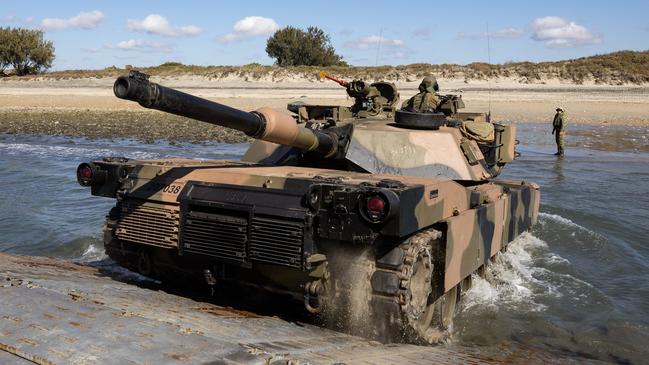
Ukraine begged Australia to donate the choppers, but the government went ahead and junked them anyway.
It was a shocking waste, and it would have been a serious political and diplomatic blunder to do it again.
The announcement that Australia will provide 49 M1A1 tanks to Ukraine has been a long time coming, and should have been made earlier.
The M1A1 tanks have long been scheduled for retirement, and the first of 75 next-generation M1A2s have already begun to arrive in Australia to replace them.
The government has faced a year-long behind-the-scenes lobbying campaign by Ukraine and its supporters for them to be pledged to the country’s war effort against Russia.
But the decision required US approval, so Anthony Albanese and Richard Marles were not alone in dragging the chain.
The alternative would have been to hand them back to the US to sit mothballed in the desert, or sell them to a third country with US permission. Neither option would have been acceptable, given Kyiv’s desperate need.
Australia has been a generous donor to Ukraine, with this latest announcement lifting the nation’s support to more than $1.5bn in military and humanitarian aid.
More than 120 Australian-made Bushmaster protected vehicles have been sent to the country, where they are highly rated by Ukrainian troops. Some have even seen action in Russia during Ukraine’s daring invasion of the Kursk border region.
Australia has also supplied drones, air defence systems, anti-tank weapons and ammunition to Kyiv, and even 3D printers. The support has been valuable but also fairly piecemeal.
Australia’s donations have had to come out of the already strained Defence budget, ensuring the department’s recommendations on potential support are coloured by the ADF’s own capability needs.
Ukraine’s pleas for some of the army’s modern Hawkei armoured four-wheel drives have fallen on deaf ears because Defence knows it would struggle to get replacement vehicles for its own needs. But the tanks were about to be retired, making it a much easier call.
The donation represents a major step-up in Australia’s support for President Volodymyr Zelensky’s forces. On paper, it’s worth about $245m – slightly less than the value of the government’s last support package, which included guided missiles, artillery, mortar and cannon shells, and small arms ammunition. But as retired Major General Mick Ryan told The Australian: “There’s nothing more lethal in close combat than a main battle tank.”
Australia’s M1A1s entered service with the army in 2007, and still have plenty of life left in them. While they are being replaced by the US and Australia, they remain among the world’s best tanks and are far superior to those operated by Russia.
Together with US-supplied models and other Western tanks, they will be used to seize and hold ground from Russian forces, as Ukraine tries to turn the tide of the war.
Ukraine’s supporters have donated more than 800 tanks to its fight against Vladimir Putin’s forces, many of which have been destroyed by drones and anti-armour missiles. But Ukrainian tank operators are changing their tactics, working in pairs with drone operators to mount hit and run raids and use their guns as highly-mobile artillery pieces.
The Australian donation comes as North Korean soldiers are reportedly being deployed to the war zone to fight alongside their Russian counterparts.
The development is an ominous one, offering Russia a deep pool of potential replacement troops. It also comes as experts believe Russia now has the upper hand in the conflict, which has been raging for more than two and a half years.




The donation of Australia’s American-made M1A1 Abrams tanks to Ukraine was inevitable after last year’s MRH-90 Taipan fiasco, when the government opted to bury perfectly usable helicopters in the ground rather than hand them to Kyiv.